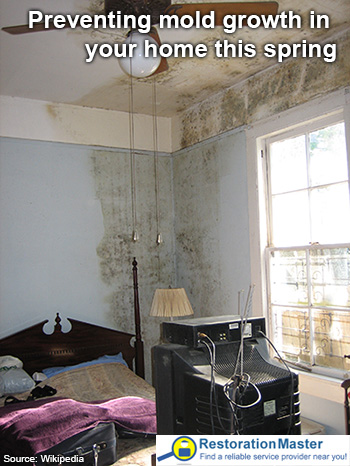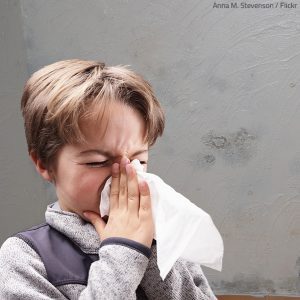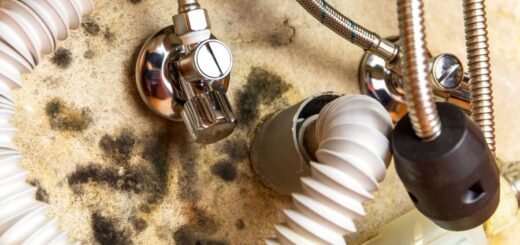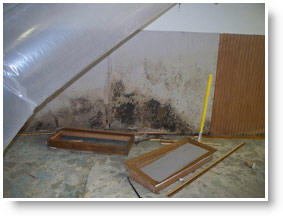Preventing Mold Growth in your Home this Spring

MoldMold is a type of fungus that grows in damp or humid conditi... More growth can occure anywhere in your house and it’s not a pretty view at all.
As the warmer weather of the spring is moving in to replace the frigid air of the winter, many homeowners across the country are breathing a sigh of relief. However, it is important to remember that new seasons bring new potential problems and while the spring weather is much more pleasant than the winter, it can still cause problems for homeowners, especially concerning moldMold is a type of fungus that grows in damp or humid conditi... More. The thaw of the last bits of ice and snow from the winter along with the higher concentration of moisture in the air create ideal conditions for moldMold is a type of fungus that grows in damp or humid conditi... More to grow. So as you open up and clean out your home this spring, make sure to be aware of high moisture or humidityHumidity is the amount of moisture or water vapor present in... More that could cause moldMold is a type of fungus that grows in damp or humid conditi... More growth.
If you control the moisture, you control the mold.
MoldMold is a type of fungus that grows in damp or humid conditi... More growth can occur just about anywhere when the right conditions are met, and moisture is a major factor in creating the right conditions. For moldMold is a type of fungus that grows in damp or humid conditi... More to appear in your home, the following must be present:
- MoldMold is a type of fungus that grows in damp or humid conditi... More sporesSpores are microscopic reproductive units of fungi or mold t... More: MoldMold is a type of fungus that grows in damp or humid conditi... More sporesSpores are microscopic reproductive units of fungi or mold t... More have a natural presence in the air and there is always a certain concentration of moldMold is a type of fungus that grows in damp or humid conditi... More sporesSpores are microscopic reproductive units of fungi or mold t... More in the air within your home.
- Food source: MoldMold is a type of fungus that grows in damp or humid conditi... More uses organic materialsOrganic materials are derived from living organisms, such as... More as its food source. Cellulose is a common food source for moldMold is a type of fungus that grows in damp or humid conditi... More, and it is found in household materials like wood, drywall, and insulationInsulation is a material used in buildings to reduce the tra... More. MoldMold is a type of fungus that grows in damp or humid conditi... More can also use dust as a food source.
- Moisture: Moisture is the main trigger of moldMold is a type of fungus that grows in damp or humid conditi... More. The moldMold is a type of fungus that grows in damp or humid conditi... More sporesSpores are microscopic reproductive units of fungi or mold t... More and food sources are always present within a home, but it is the presence of moisture that causes moldMold is a type of fungus that grows in damp or humid conditi... More to grow. Moisture from water damage, indoor floodingFlooding is the overflow or accumulation of water in areas t... More, condensation, and humidityHumidity is the amount of moisture or water vapor present in... More can leadLead is a heavy metal that can be toxic to humans, especiall... More to moldMold is a type of fungus that grows in damp or humid conditi... More growth.
This is why controlling the moisture level in your home is so important for preventing mold growth, especially in the spring when moisture levels are higher. High moisture levels can cause moldMold is a type of fungus that grows in damp or humid conditi... More sporesSpores are microscopic reproductive units of fungi or mold t... More which are ever present in the environment to latch onto surfaces such as wood, drywall, or insulationInsulation is a material used in buildings to reduce the tra... More and start growing.
It is best to maintain a moisture level of 30-50 percent. Moisture levels above 50 percent create conditions that are favorable for moldMold is a type of fungus that grows in damp or humid conditi... More growth but allowing the moisture to drop below 30 percent can impact your health. Make sure the areas of your home that produce a lot of moisture, such as the kitchen, bathroom, and laundry room, are well ventilated to reduce moisture buildup. You can test the moisture level in your home yourself with a hygrometer or call a professional for a more thorough moisture test.
If moldMold is a type of fungus that grows in damp or humid conditi... More growth does occur in your home, it is important to identify it immediately because it can cause property damage and health issues for those with a sensitivity to moldMold is a type of fungus that grows in damp or humid conditi... More.
Finding MoldMold is a type of fungus that grows in damp or humid conditi... More Growth
While the sight of moldMold is a type of fungus that grows in damp or humid conditi... More is an obvious indication of moldMold is a type of fungus that grows in damp or humid conditi... More growth in your home, moldMold is a type of fungus that grows in damp or humid conditi... More might not always be visible. It can grow within walls, behind molding, and in hidden corners throughout the home which can be more difficult to discover. One way to find hidden moldMold is a type of fungus that grows in damp or humid conditi... More growth is to smell it. MoldMold is a type of fungus that grows in damp or humid conditi... More can produce a musty odorAn odor is a smell, often detectable by the human nose, whic... More and if there is a strong musty smell in your home, there is a good chance it could be caused by hidden mold. Try to locate the source of the smell the best you can to find the growth.
Another way to find hidden moldMold is a type of fungus that grows in damp or humid conditi... More growth is to check areas prone to water damage. Kitchens and bathrooms as well as areas around doors and windows are susceptible to water damage so make sure to check these areas for excessive moisture or moldMold is a type of fungus that grows in damp or humid conditi... More growth.
You should also check areas near pipes, plumbing fixtures, air conditioners, and anything else that is prone to condensation buildup. Pipes with leaks or condensation buildup are a major cause of hidden moldMold is a type of fungus that grows in damp or humid conditi... More growth within walls. Make sure you check your basement, attic, and crawlspace often as these areas may experience moisture issues and they typically have poor ventilationVentilation is the process of exchanging or circulating air ... More.
Preventing MoldMold is a type of fungus that grows in damp or humid conditi... More this Spring

MoldMold is a type of fungus that grows in damp or humid conditi... More causes not only structural damage but various health risks as well.
If you discover moldMold is a type of fungus that grows in damp or humid conditi... More in your home, the extent of the moldMold is a type of fungus that grows in damp or humid conditi... More growth will determine whether it should be handled by a mold removal specialist or if you can remove it yourself. Unless the growth is very minor, it is best to hire a professional to remove it. Attempting to remove moldMold is a type of fungus that grows in damp or humid conditi... More growth without the proper techniques or equipment can make the problem worse. MoldMold is a type of fungus that grows in damp or humid conditi... More colonies will respond to being disturbed by releasing their sporesSpores are microscopic reproductive units of fungi or mold t... More which will spread the moldMold is a type of fungus that grows in damp or humid conditi... More growth and increase the damage to your home. Improper cleaning methods will also put you at a much higher risk for related health effects. Mold removal professionals are trained and equipped to contain the moldMold is a type of fungus that grows in damp or humid conditi... More and remove it effectively without allowing it to spread.
Because moldMold is a type of fungus that grows in damp or humid conditi... More is a dangerous substance and very difficult to remove, moldMold is a type of fungus that grows in damp or humid conditi... More preventionPrevention refers to actions taken to reduce the likelihood ... More is the best action you can take. The following tips will help you keep your home moldMold is a type of fungus that grows in damp or humid conditi... More free this spring:
- Clean out your gutters and keep them in working order.
- Fix water leaks from plumbing fixtures or pipes as soon as you find them.
- Wipe off condensation that may be found on windows, pipes, plumbing fixtures, and walls.
- Water spills and leaks should be dried up immediately before moldMold is a type of fungus that grows in damp or humid conditi... More has a chance to form.
- Minor moldMold is a type of fungus that grows in damp or humid conditi... More growth can be scrubbed off of walls and other hard surfaces with water and detergent.
- Clean out the drip pans of your air conditioner.
- Try your best to keep the humidityHumidity is the amount of moisture or water vapor present in... More level in your home below 50 percent.
The spring season is an exciting time that brings pleasant weather, but the weather conditions of the spring are often wetter than those of other seasons. This is why it is important for homeowners to pay attention to the moisture level of their homes and watch out for moldMold is a type of fungus that grows in damp or humid conditi... More growth during the spring. Taking the right precautions can help you avoid moldMold is a type of fungus that grows in damp or humid conditi... More but if you do discover moldMold is a type of fungus that grows in damp or humid conditi... More growth in your home, it is best to contact a mold remediation professional to handle the problem. You must address any moldMold is a type of fungus that grows in damp or humid conditi... More problem quickly because the resulting damage and risk of negative health effects will increase until the moldMold is a type of fungus that grows in damp or humid conditi... More is removed.












